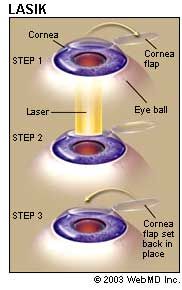Before touching the contact lens or one's eyes, it is important to thoroughly wash and rinse hands with a soap that does not contain moisturizers or allergens such as fragrences. The soap should not be antibacterial due to risk of improper hand washing and the possibility of destroying the natural bacteria found on the eye. These bacteria keep pathogenic bacteria from colonizing the cornea. The technique for removing or inserting a contact lens varies slightly depending upon whether the lens is soft or rigid.
In all cases, the insertion and removal of lenses requires some training and practice on the part of the user, in part to overcome the instinctive hesitation against actually touching the eyeball with one's fingertip.
Insertion
Contact lenses are typically inserted into the eye by placing them on the index finger with the concave side upward and raising them to touch the cornea. The other hand may be employed to keep the eye open. Problems may arise particularly with disposable soft lenses; if the surface tension between the lens and the finger is too great the lens may turn itself inside out; alternatively it may fold itself in half. When the lens first contacts the eye, a brief period of irritation may ensue as the eye acclimatizes to the lens and also (if a multi-use lens is not correctly cleansed) as dirt on the lens irritates the eye. Irrigation may help during this period, which generally should not exceed one minute. It may be noted that although with some types of contact lenses it is easy to tell if you have inserted the lens backwards (as it is usually painful and vision is impaired) you are able to determine the lens's correct position beforehand by holding the lens on the tip of your finger and squeezing the bottom of it with two fingers from your other hand, you will know you have it the correct way if the edges of the lens curve inward like a taco. If they curve out you need to flip the lens. With some types of lenses however, this is difficult as both sides look very much the same. With many lenses it is hard to tell whether they are inside out or not even when they are in the eye itself. This is because the vision and feel of the lens can be very similar for both sides. For these reasons many people try to ensure they keep visual track of the different sides of the contact lenses from the day they are open, if they suspect the lens is inside out they can always change its orientation at a later stage. It is never advisable to wear the lenses inside-out even if they feel comfortable and vision is good when doing so.
Removal
A soft lens may be removed by holding the eyelids open and grasping the lens with opposing digits. This method may cause irritation, could risk damage to the eye and may in many cases be difficult, in part due to the blink reflex. If the lens is pushed off the cornea (by touching the lens with your forefinger and looking towards your nose, moving the lens) it will buckle up (due to the difference in curvature), making it easier to grasp.
A soft lens may be removed by holding the eyelids open and grasping the lens with opposing digits. This method may cause irritation, could risk damage to the eye and may in many cases be difficult, in part due to the blink reflex. If the lens is pushed off the cornea (by touching the lens with your forefinger and looking towards your nose, moving the lens) it will buckle up (due to the difference in curvature), making it easier to grasp.
As an alternative method to grasping, once the lens is moved off the cornea to the inner corner of the eye, it can be pushed out of the eye by pressing downwards on the upper eyelid with a finger. With this method there is less risk of touching the eye with the fingers, and it may be easier for people with long fingernails.
Rigid contact lenses may be removed by pulling with one finger on the outer or lateral canthus, then blinking to cause the lens to lose adhesion. The other hand is typically cupped underneath the eye to catch the lens. There also exist small tools specifically for removing lenses, which resemble small plungers made of flexible plastic; the concave end is raised to the eye and touched to the lens, forming a seal stronger than that of the lens with the cornea and allowing the lens to be removed from the eye.
Tags:
Contact lens


































